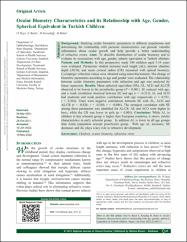| dc.contributor.author | Dayi, Özlem | |
| dc.contributor.author | Bulut, Erkan | |
| dc.contributor.author | Karadağ, Mevlüde | |
| dc.contributor.author | Bulut, Hatice | |
| dc.date.accessioned | 2023-10-24T11:15:46Z | |
| dc.date.available | 2023-10-24T11:15:46Z | |
| dc.date.issued | 2022 | en_US |
| dc.identifier.issn | 1119-3077 | |
| dc.identifier.uri | https://hdl.handle.net/11363/6040 | |
| dc.description.abstract | Background: Studying ocular biometric parameters in different populations and
determining the relationship with personal characteristics can provide valuable
information about ocular growth and help provide a better understanding
of refractive errors. Aims: To describe distributions of ocular biometry and to
evaluate its associations with age, gender, spheric equivalent in Turkish children.
Patients and Methods: In this prospective study 344 children aged 3-14 years
were evaluated. Parameters studied included axial length (AL), anterior chamber
depth (ACD), and mean corneal radius (CR) measured with optical biometry.
Cycloplegic refraction values were obtained using autorefractometer. The change of
biometric parameters according to age and gender were evaluated. The relationship
between ocular biometry parameters with refraction and age was analyzed by
linear regression. Results: Mean spherical equivalent (SE), AL, ACD and AL/CR
observed to be lowest in the preschooler group (P < 0.001). SE reduced with age,
and a weak correlation observed between SE and age (r = ‑0.333). AL and ACD
had moderate and weak positive correlations with age respectively (r = 0.511;
r = 0.304). There were negative correlations between SE with AL, ACD and
AL/CR (r = -0.826; r = -0.540; r = -0.886). The strongest correlation with SE
among these parameters was identified for AL/CR. AL and ACD were higher in
boys, while the CR was lower in girls (p < 0.001). Conclusion: While AL in
children in late schooler group is higher than European countries, it shows similar
characteristics in early schooler group. In addition AL is lower in all age groups
than Asian population sexcept preschooler group. With age AL increases, SE
decreases and AL plays a key role in refractive development. | en_US |
| dc.language.iso | eng | en_US |
| dc.publisher | WOLTERS KLUWER MEDKNOW PUBLICATIONS, WOLTERS KLUWER INDIA PVT LTD, A-202, 2ND FLR, QUBE, C T S NO 1498A-2 VILLAGE MAROL, ANDHERI EAST, MUMBAI, Maharashtra 400059, INDIA | en_US |
| dc.relation.isversionof | 10.4103/njcp.njcp_1277_21 | en_US |
| dc.rights | info:eu-repo/semantics/openAccess | en_US |
| dc.rights | Attribution-NonCommercial-NoDerivs 3.0 United States | * |
| dc.rights.uri | http://creativecommons.org/licenses/by-nc-nd/3.0/us/ | * |
| dc.subject | Children | en_US |
| dc.subject | ocular biometry | en_US |
| dc.subject | refractive error | en_US |
| dc.title | Ocular Biometry Characteristics and its Relationship with Age, Gender, Spherical Equivalent in Turkish Children | en_US |
| dc.type | article | en_US |
| dc.relation.ispartof | Nigerian Journal of Clinical Practice | en_US |
| dc.department | Sağlık Hizmetleri Meslek Yüksekokulu | en_US |
| dc.identifier.volume | 25 | en_US |
| dc.identifier.issue | 5 | en_US |
| dc.identifier.startpage | 569 | en_US |
| dc.identifier.endpage | 575 | en_US |
| dc.relation.publicationcategory | Makale - Uluslararası Hakemli Dergi - Kurum Öğretim Elemanı | en_US |
| dc.contributor.institutionauthor | Bulut, Erkan | |
| dc.contributor.institutionauthor | Bulut, Hatice | |



















